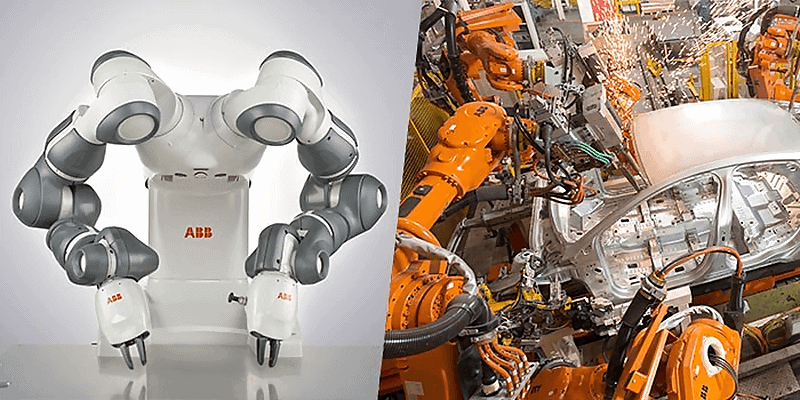Cobots or collaborative robots or co-robots referred to the robots meant to physically interact or support the person in his work area at the manufacturing plant or in simple language specially designed robots which can work alongside human employees with coordination.
The main aim to introduce Cobots in the manufacturing process is to provide more flexibility, accuracy, and continuous speed in the process with safety. Thanks to innovation on sensors, basic artificial intelligence, and advancement in robotics, collaborative robots (Cobots) can interact directly and safely with humans.
But still many people in industrial sectors are not aware of the difference between traditional robots and cobots. In this article, I will try to share maximum information about the cobots and how it is different than robots and why it is a better option or it’s a myth.
What is Cobots?
At first, what applications or areas we can automate with Cobots. Normally as standard ideal applications for cobots are repeating, manual processes that happen around human workers but don’t require human skill, critical thinking, or on-the-spot decisions.
But recent innovations in AI provide more freedom and basic decision-making ability to the cobots. Also, in the areas in the manufacturing plants where employees required to contact dangerous machines, cobots are more useful and efficient further can reduce ergonomic injuries.
The areas where robots can be used are always simple and with the same pace as the human. Cobots provide results to increment productivity and offer consistent, dependable output that liberates employees from low-adeptness jobs, so they can work on higher-value activities.
Also, for higher speed than humans, other systems might be required to integrate.
The range of Cobots can reach a maximum of 1300 mm in length and carry a maximum of 10 kgs. based on the payloads for bigger applications with long reach multiple Cobots can be used to automate the process.
Cobots work in virtually any environment that humans can work in, without repining about temperature, noise, or dirt with the exception that they can work in hygienic environments or are even cleanroom-certified.
But like any equipment (or human workers, for that matter), Cobots in extreme environments may need additional safety accessories.
The major drawback of cobots is that they cannot be used in heavy applications and large materials movement.
And now how it is different than robots. Industrial robots are designed to automate the complete process without any human interference in the manufacturing plant.
Robots are more powerful and complex in terms of design and process.
What are the differences between Cobots and robots are?
1) Collaboration of human and machine
Cobots are designed to work alongside human employees, while industrial robots do work in place of those employees. Industrial robots are performed out their work without regard for the people working around them. Accidents are prevented using fences and cages in the case of robots whereas in cobots mostly times it’s not required.
2) Flexible, teachable, and user friendly
Cobots are easily programmable and less complex. They are flexible and designed to learn the required job with the guidance of humans. Changes of movement of the flexible arm of cobots are very simple and easy. Whereas industrial robots required complex programming codes with set instructions of movement and steps. Also, cannot be so easily reprogrammed, and require an engineer to write new code for any changes in the process to be implemented.
3) Easy relocation and risk-free
Cobots can easily move from one place to another in manufacturing area (lightweight) and less risky (can be mounted on any surface – horizontal, vertical, on the ceiling.) because of no restriction of movement and due to advance sensors whereas robots majorly cannot be relocated easily (heavyweight) and required cage or fence to make the place safer for humans and need a specific place for mounting.
4) Cost and customization
Cobots cost most times will be less as compared to industrial robots but this point is analogous because in both cases customization due to their size and differences in capacity and application decide the final cost. Further output difference and benefits involved are always different in both cases.
Cobots help to increase the motivation level of employees because they are going to be used to optimize the process not to replace people as in the case of Robots (except in the case of the only solution available).
Cobots promotes the tasks where creativity, solution-oriented thinking, and initiative are given more space in the manufacturing plant.
Whereas industrial robot requirements in heavy applications, extreme environments, and special applications cannot be ignored and highly recommended to increase the optimization of the manufacturing process. Industry-wise Automotive sector majorly using industrial robots whereas the pharma, food, packaging sector considered cobots as a better option.
There are many questions that must be addressed in deciding whether an industrial robot or cobot is best suited for any project. Based on the automation goals, how much space available for automation equipment, are processes fixed, or do they change regularly?
Thank you for reading. We hope this gives you a good understanding. Explore our Technology News blogs for more news related to the Technology front. AdvanceDataScience.Com has the latest in what matters in technology daily.




